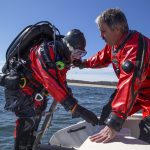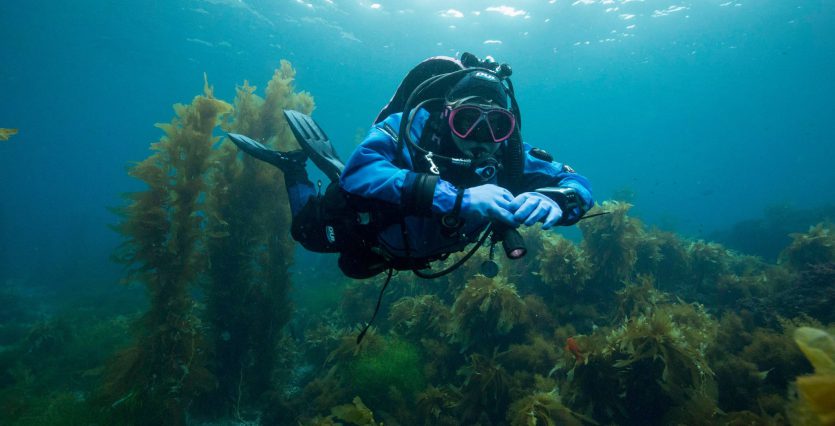The first thought that many divers have when contemplating cold water diving is: “Brrrrr! Why would anyone want to do that?” The short answer: AMAZING diving. Colder water tends to have more nutrients, and typically more nutrients equal more life. The sheer amount of diverse biota in colder waters is absolutely stunning. A diver could have thousands of dives in a given region of cold water and on every single dive see some never-before-seen species or behavior — not to mention encounters with species that cannot thrive, let alone survive, in warmer waters.
 Cold water is not limited to wintertime diving. In some locations, such as the Pacific Northwest or in the North Sea, summertime water temperatures may only reach 13 to 15 degrees Celsius (55 to 60 degrees Fahrenheit). Divers in these areas deal with cold water diving all 12 months of the year. Also, many popular dive sites are in deeper and colder water.
Cold water is not limited to wintertime diving. In some locations, such as the Pacific Northwest or in the North Sea, summertime water temperatures may only reach 13 to 15 degrees Celsius (55 to 60 degrees Fahrenheit). Divers in these areas deal with cold water diving all 12 months of the year. Also, many popular dive sites are in deeper and colder water.
Diving in cold water is, however, not without some specific challenges. Unlike warmer waters, divers face some unique factors when planning and executing their dives.
When first getting into the water, divers often experience two things — a change in their breathing and the urge to urinate. The change in breathing is due to a physiological reaction often called the mammalian diving reflex (MDR), a response of our bodies to being immersed in cool/cold water. Several things happen when the MDR engages. First, the heart rate slows. It can actually slow down as much as 50 percent. The second is peripheral vasoconstriction. The blood vessels of the extremities narrow and reduce blood flow to the arms, hands, legs and feet, allowing the more oxygen-demanding organs, like the heart and brain, to receive the oxygen they need. The MDR has other effects, but they are beyond the scope of this article.
The urge to urinate is due to an effect called immersion diuresis. Immersion diuresis is also caused by vasoconstriction. Triggered by the cold water, blood shifts to the body core. This causes the body to think that there is too much fluid volume, and the response of the kidneys is to remove fluid. This urge is often compounded with any alcohol consumed the night before or the cup(s) of coffee consumed in the morning. Alcohol and caffeine are diuretics. Diuretics cause the kidneys to work harder, producing more urine and increasing the need and urgency to relieve that pressure.
Consider some tips to help address these issues.
Avoid, or at least limit, your alcohol and caffeine intake in the hours before the dive. This simple step will aid in minimizing vasoconstriction and decrease, though not eliminate, the urge to urinate. Make sure you hydrate. Water or electrolyte drinks are great. Decaffeinated or herbal tea is good if you want something warm.
Give yourself time to acclimate to the cold water. Ease your way in. Before you begin the dive, dunk your face into the water to give your face and head a chance to acclimatize. Have students flood and clear their masks several times in shallow water so they know what to expect at depth if they have to clear their masks.
When diving from a boat, do a controlled seated entry from the stern, if possible. Submerging your legs for a few seconds will give your body an opportunity to get used to the colder water. After entry, spend a few moments at the surface getting adjusted. This makes the dive that much more enjoyable. If spending some time getting used to the water is not possible, an alternative is to use a towel soaked in cold water to cover your face, especially the forehead and sinus area. This triggers the MDR and helps your body to relax and get somewhat used to the upcoming cold immersion.
When our bodies are cold or in a cold environment, they burn more calories to produce warmth, especially for the core. When a diver does not have enough food energy available, the body will start using whatever it can to help produce heat. If you are diving on an empty stomach, your body will actually get colder faster. You won’t have the fuel you need to keep warm, and you will become chilled much more quickly. The solution is easy: Eat! Warm foods with carbohydrates are perfect for this. Have a sandwich or snack ready to eat during your surface interval.
Although recreational divers seldom reach the point of clinical hypothermia (see other articles in this issue), extreme chilling or even hypothermia is always a concern when diving in cold water. Heat is drawn off our bodies 25 times faster in water than in air. Unless diving a drysuit with a dry hood, dry gloves and full face mask, part of your body will be exposed to the colds. The best way to avoid getting too cold is to prepare for it well in advance. Wear the proper gear, call the dive if you begin to get too cold, and have the ability to get warm quickly.
Preventing further heat loss is key to treating hypothermia. Get the diver to a sheltered, and preferably warm, area. If shelter is not immediately available, protect the diver from any exposure by using blankets, tarps and anything that can be used as a makeshift shelter. As soon as possible, replace wet clothing with dry, warm clothing, including a head covering. Once further heat loss has been prevented, the rewarming process can begin. Actively warm the diver by applying heat packs to significant superficial arterial sites, e.g., neck, underarms, groin. If the diver is fully conscious, provide warm, high-energy, nonalcoholic drinks and foods. Then, seek additional medical attention.
While most divers will never get true clinical hypothermia from diving in cold water, they still may get chilled and need to take steps to keep warm in between dives. First, leave your hood and (wet) gloves on until you can replace them with a hat and (dry) gloves. As you are on the surface and approaching the shore or boat, your hood and gloves offer insulation. Wait until you are back to the shore or boat to remove them.
Some warm beverages and food are helpful in getting and keeping warm. Make heat packs available. Bri ng along a cooler of hot water. Dunk hoods and gloves in the water to keep them warm. This will help with heat conservation when redonning for a repetitive dive. The hot water can also be used to thaw an ice-locked zipper or frozen regulator. These tips can make the difference between getting and keeping warm, and being chilled and miserable on a second or third dive.
ng along a cooler of hot water. Dunk hoods and gloves in the water to keep them warm. This will help with heat conservation when redonning for a repetitive dive. The hot water can also be used to thaw an ice-locked zipper or frozen regulator. These tips can make the difference between getting and keeping warm, and being chilled and miserable on a second or third dive.
Equipment plays a significant role when diving cold water. The obvious consideration is thicker wetsuits, semi-dry suits or drysuits. Using a drysuit requires additional training. The NAUI Drysuit Diver specialty course is a great option to learn how to use this piece of equipment. Be aware that with thicker wetsuits and drysuits, additional weight is needed. Be sure the exposure protection you are using is properly fitted to help in heat retention.

Equipment selection for use in cold water dives is not limited to exposure protection. Use regulators that are designed for use in cold water. Look for regulators that have the European EN250 rating. Some divers choose to use a low-pressure cylinder. In cold air, limit breathing through a wet regulator on the surface, which can lead to freeze-up of the regulator.
Necessary equipment for cold water diving is not limited to what you use in the water. Bring a warm, windproof coat that can be easily slipped on over your chosen exposure protection. Remember hat and gloves too. Don’t forget your feet! There is not much worse than getting out of a drysuit and getting your feet wet from anyresidual water on the boat or shore. Have an extra pair of warm socks and dry shoes handy. Your feet will thank you.
Plan your dives to be more conservative. If using dive tables, don’t be afraid to “bump up’” your dive letter group by one or even two letters if the dive was cold and/or strenuous. Reducing in-water times will decrease your exposure to cold water. Diving in cold water can increase gas consumption, so plan accordingly. Bring more gas than usual and limit bottom time and/or depth until you have a good baseline for gas consumption. Know how to handle a free-flowing regulator. Cold water can make regulators more prone to free-flowing. Being comfortable with air-sharing skills is paramount, so practice them often.
While all this may seem like a great deal of information, even daunting to some divers, these small tips and steps can make the difference in having a successful and enjoyable day of diving in the cold water. Don’t short yourself the opportunity for cold water diving; it is absolutely wonderful when you are fully prepared for it.


